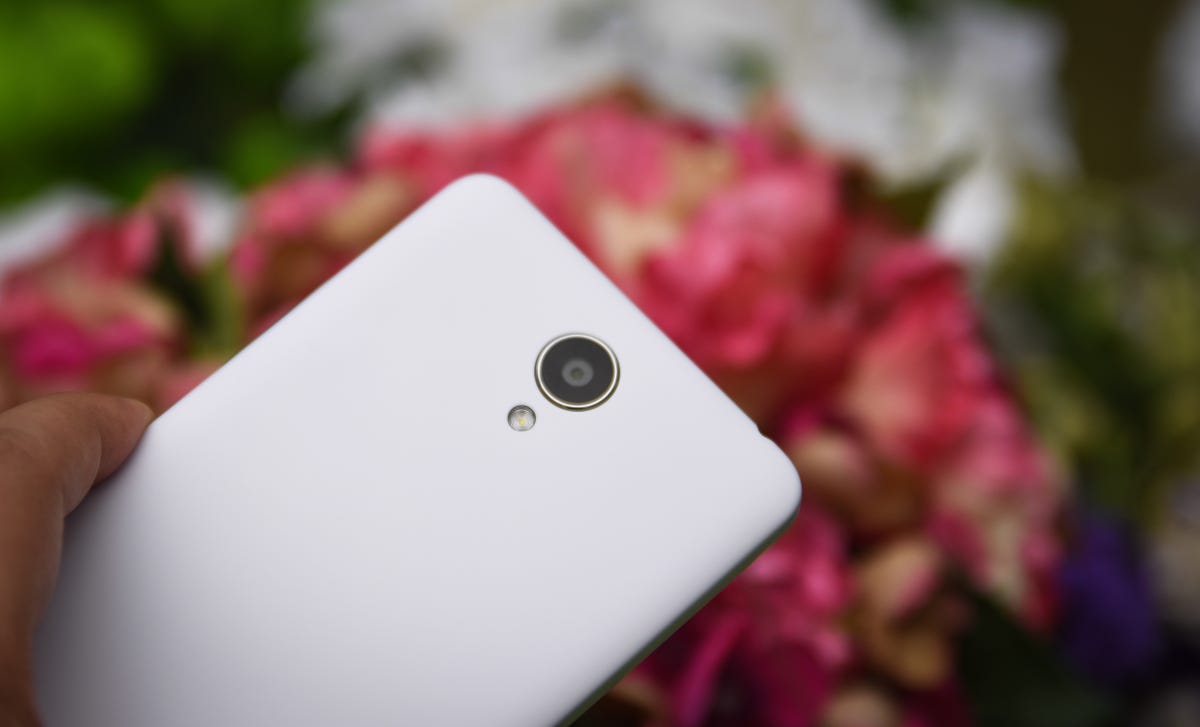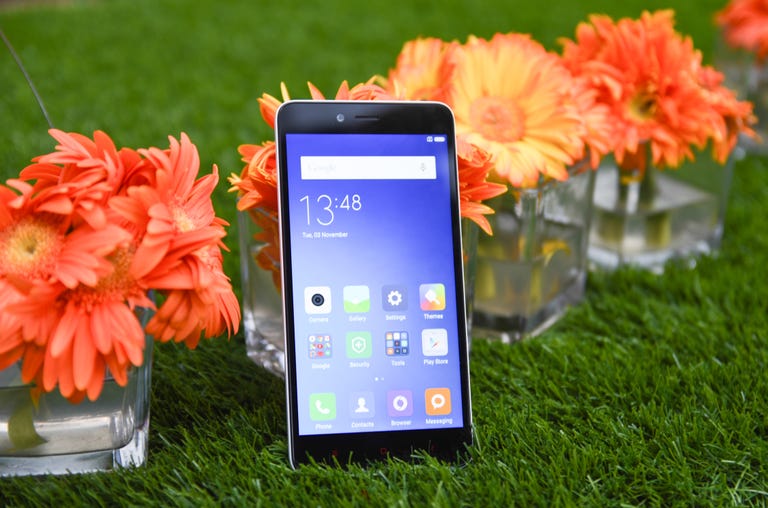 Why You Can Trust CNET
Why You Can Trust CNET Xiaomi Redmi Note 2 review: Speedy performance for cheap
Xiaomi's decision to use MediaTek's Helio X10 processor for its budget phablet proves to be the right choice.
Xiaomi's latest smartphone, the Redmi Note 2, is the kind of phone you're looking for when you need a big screen and features at a low cost, even if its specs aren't all that exciting. As the last new phone the Chinese smartphone maker is selling outside of China for the rest of the year, this is the budget large screen phone to try especially if you've never heard of Xiaomi before.
The Good
The Bad
The Bottom Line
Personally, I don't really like displays larger than 5 inches, as they make it a tad uncomfortable to use with one hand, but the 5.5-inch Redmi Note 2 didn't seem too hard to get used to. Perhaps it's because I've been testing out the Apple Watch with the 5.5-inch iPhone 6S Plus, which may have made the transition easier.
Like all Xiaomi phones, the Redmi Note 2 runs a custom version of Android called MIUI, and like most Chinese smartphones it takes a page out of Apple's design handbook and puts all the apps on the home screen by default. Also, Xiaomi likes to keep things lean, so you'll find a lack of irritating bloatware, which is always a plus. The 13-megapixel camera isn't the best, but it will take pretty decent pictures with enough natural light.
The phone retails for a mere $150, which converts to around £100 or AU$210, though if you're getting one from third-party online retailers, expect to pay a slight premium. It's a pretty decent phone, especially if you're looking for a cheap device you can take overseas, and it works well for this thanks to its dual-SIM capabilities.
Where can I get this phone?
Xiaomi sells the phone in Taiwan, Hong Kong, Malaysia and Singapore. There's no word on whether it will ever be sold in the US, UK or Australia, but based on Xiaomi's pattern, likely not. The company is making inroads in India and Brazil, so if we were to see it land anywhere else, I'd put my money on one of those countries.
Can I still by the phone if I don't live in Asia?
Third-party online retailers usually stock Xiaomi products, so there's a good chance you can get one for a slight premium. There are a few caveats to note, firstly, warranty may be limited, and you'll have to make sure you're getting the non-China version if you want the Google Play store preinstalled. Otherwise you'll have to do some work yourself to get the apps working on the phone.
Which 4G networks is the phone compatible with?
There's good and bad news. Right now, the Xiaomi Redmi Note 2 supports a range of 4G networks, which includes UK carriers like Three and EE, and should support the LTE networks of Optus, Telstra and Vodafone in Australia. The bad news is that 4G won't work in the US, although 3G will.
What are the Redmi Note 2's main features?
Apart from having a 5.5-inch full-HD display, the Note 2 sports a MediaTek Helio X10 octa-core 64-bit processor. It also has 2GB of RAM, which isn't a lot, as well as a mere 16GB of onboard storage, but it does have a microSD card slot if you need more storage. The Redmi Note 2 comes with dual-SIM 4G, which is pretty good if you are traveling overseas and want to use a local SIM card to save on roaming fees, without removing your everyday SIM.
I like taking photos -- is the Redmi Note 2's camera any good?
The 13-megapixel rear camera is fine, but not terrific. If you're in the bright outdoors, you'll find that pictures generally turn out sharp with colors that are generally true to life. It struggles a bit indoors under fluorescent lighting, and does have some issues with color accuracy then.
The Note 2's camera locks onto objects pretty quickly thanks to its 0.1s phase detection autofocus, which is another plus and there are a bunch of software enhancements, such as panorama mode for taking wide landscape shots. The front camera isn't too shabby; you'll be able to take good-looking 5-megapixel selfies thanks to the phone's built-in Beautify mode.
How does the size compare to other big phones?
While it has the same screen size as the iPhone 6S Plus (5.5 inches), the Redmi Note 2 is actually smaller in size overall, though it's still slightly thicker than the 6S Plus. Compared against, say, the more expensive Huawei Mate S, which has a similar-sized display, the Mate S is just a hair smaller, though you'll find both to be around the same size.
I'm not familiar with Xiaomi's MIUI; what's good about it?
MIUI is Xiaomi's take on Android, and if you're switching from iOS, you'll feel right at home. Like iOS, MIUI drops the Android app drawer (where the apps are usually found) in favor of putting all the apps on the home screens. You can easily sort apps into folders, and there's a smart feature that lets you use one digit to drag an app icon while using another one to flip the "page" to get to a new screen. This is way easier than bringing the app to the edge of the display the way you do in Apple's iOS.
Interesting. What's this sorting feature?
Perform a pinch motion on any home screen, then simply tap an app to send it to a holding area. You can tap more apps to collect them, before swiping over to a new home screen and placing them all there or in a folder.
Which version of Android does MIUI run on?
The Redmi Note 2 runs MIUI 7, which is based on Android 5.0. There's no word on whether the phone will be updated to Android 6.0 Marshmallow just yet.
What are the main issues with Xiaomi's MIUI?
Generally speaking, MIUI is simple to use, but I'm a big fan of the Android app drawer, which Xiaomi's interface lacks. This isn't a big deal for most, I suspect, so it really boils down to personal preference. MIUI also has a lot of hidden useful features, such as turning on the flash while at the lock screen by holding down the Home button, but you really wouldn't know about this unless you're a power user.
How long does the phone's battery last?
I found the phone to easily last me through the day on a full charge, and was able to hit 9 hours and 10 minutes in our continuous video playback tests. That's a pretty decent timing, especially for a phone with a 3,060mAh battery -- the OnePlus 2, which had a 3,300mAh battery, checked in at 9 hours 46 minutes. It's still not as good as the Samsung Galaxy Note 5, however, as the 3,000mAh battery of the Note 5 easily lasted 15 hours in our tests.
Is the battery removable?
Yes! If you're afraid that the battery might not last long enough for you, there's always the option of swapping it out for a fresh one. You can do this on the Redmi Note 2, and a fresh spare battery is obviously lighter than carrying a portable charger around.
The phone only has 16GB of onboard storage. What happens when I need more?
Well, the good news is that the Redmi Note 2 has a microSD card slot that supports up to 32GB of storage space. This means you'll be able to get up to 52GB of storage if you need it. MIUI is pretty lean in the first place, and even after installing a bunch of apps and our test video file, I still had 6GB of space left. So no worries here.
How much better is the Redmi Note 2 compared to the original?
Well, the short answer is that it's a lot better. The Redmi Note 2 uses design elements from the Xiaomi Mi 4i, resulting in a slimmer, more even profile that looks so much nicer. It's slightly smaller and lighter, and has a higher-resolution display to boot.

Five color options mean you won't be stuck with only black or white.
If I don't like the rear cover color, are there any other options?
The Xiaomi phone comes in five different colors, white, dark gray, blue, pink and yellow. You can also buy a different cover to replace it, or use a different color snap-on case to change the phone's look.
How does the phone measure up in benchmarks?
Testing done on Geekbench 3 show that the MediaTek Helio X10 chip is a tad more powerful than the Qualcomm Snapdragon 615 processor, which is great, as you'll be getting a bit more performance at a much cheaper price -- and this includes Xiaomi's own midrange Mi 4i, which the Note 2 beats in both price and performance.
Which is better, the Xiaomi Redmi Note 2 or the Asus ZenFone Selfie? Which other phones could I get instead?
At $150, the Redmi Note 2 is quite a steal, I reckon, given its much better performance and the very important fact that it comes without the bloatware plaguing the ZenFone Selfie. Even with the usual slight premium from third-party online retailers, the Note 2 will likely still shine in value. Phones such as the Alcatel OneTouch Idol 3 or the Droid Maxx 2 are more expensive while offering performance that's slightly under the Note 2.
Is the Redmi Note 2 worth the $150 asking price?
Yes, the Redmi Note 2 is Xiaomi's best budget phone this year, so look no further if you're hunting for a cheap Xiaomi phone. The phone easily shows why Xiaomi's making plenty of waves with its gadgets and proves that you don't have to skimp on quality with budget devices.


